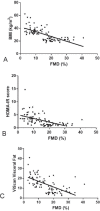SERUM OMENTIN-1 LEVELS AND ENDOTHELIAL DYSFUNCTION IN OBESITY
- PMID: 31149164
- PMCID: PMC6516446
- DOI: 10.4183/aeb.2017.138
SERUM OMENTIN-1 LEVELS AND ENDOTHELIAL DYSFUNCTION IN OBESITY
Abstract
Introduction: Our aim was to investigate the relationship between serum omentin-1 levels and endothelial dysfunction in obese patients.
Material and methods: We evaluated 50 obese patients, and age/gender matched 45 healthy non-obese subjects as controls. Oral glucose tolerance test, lipid parameters, uric acid levels, homeostatic model assessment-insulin resistance (HOMA-IR) index, serum omentin-1 levels and flow mediated dilatation (FMD) % were measured in all subjects. Body compositions were analyzed with bioelectrical impedance method using a Tanita Body Composition Analyzer and ViScan.
Results: Serum omentin-1 levels were found significantly lower in obese population compared to the control subjects. FMD response was significantly decreased in obese population. There was a significant positive correlation between serum omentin-1 levels and FMD response (r=0.359, p<0.001). Serum omentin-1 levels were negatively correlated with body mass index (BMI), waist circumference, total fat percentage, visceral fat, fasting insulin and HOMA-IR index.
Conclusion: Lower serum omentin-1 levels and decreased FMD response may be an early marker of endothelial dysfunction in obese patients.
Keywords: Endothelial Dysfunction; Flow Mediated Dilatation; Obesity; Omentin-1.
Conflict of interest statement
The authors declare that they have no conflict of interest concerning this article.
Figures


References
-
- Galic S, Oakhill JS, Steinberg GR. Adipose tissue as an endocrine organ. Mol Cell Endocrinol. 2010;316:129–139. - PubMed
-
- Ohashi K, Shibata R, Murohara T, Ouchi N. Role of anti-inflammatory adipokines in obesity-related diseases. Trends Endocrinol Metab. 2014;25:348–355. - PubMed
-
- Ghoorah K, Campbell P, Kent A, Maznyczka A, Kunadian V. Obesity and cardiovascular outcomes: a review. Eur Heart J Acute Cardiovasc Care. 2016;5(1):77–85. - PubMed
LinkOut - more resources
Full Text Sources
